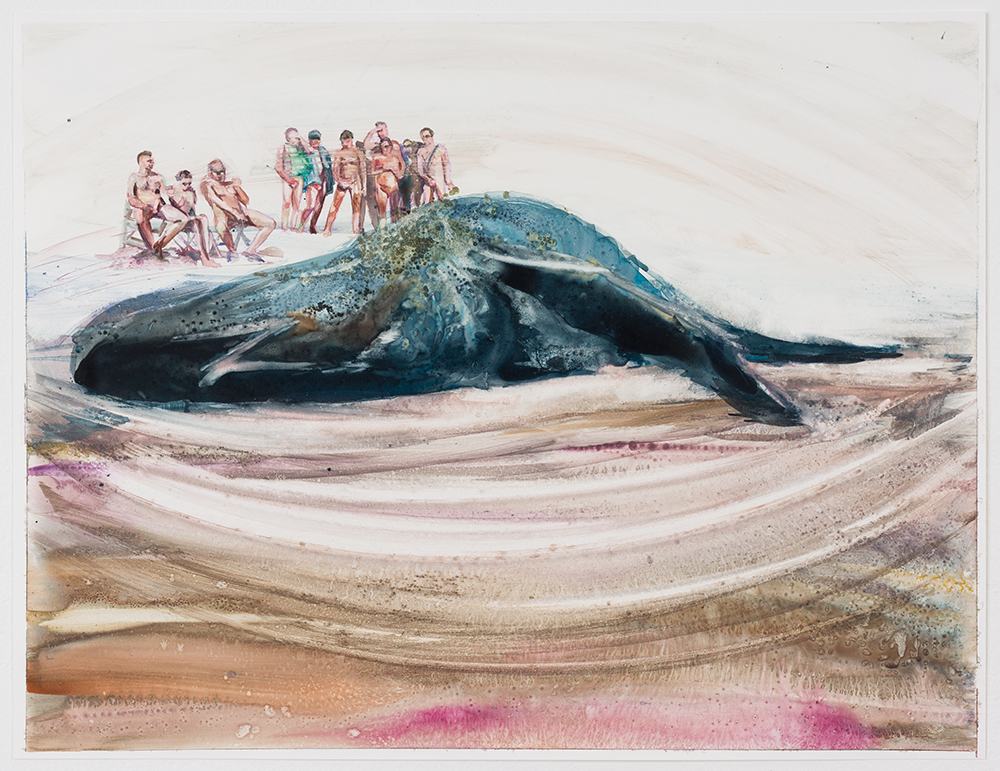Like many other pictorial artists, Molly Segal is a storyteller. Her preferred medium is watercolor applied in various degrees of thickness to a special plastic-coated paper that is less absorbent than conventional papers, but also more easily re-worked. The titles of these works—variously satiric, scabrously funny, foreboding and matter-of-fact—function essentially as captions to her narratives. Her show, “What We Whispered and What We Screamed,” is the apocalyptic Anthropocene—social disintegration in the wake of the collapse of the biosphere and civilization—already in evidence everywhere from city-wildland interface to derelict patches of urban and suburban real estate.
Her approach is both technically and narratively irreverent. She stains, shadows, swipes, swirls, sponges, even salts the surfaces of the paintings. And certainly (with a built-in assist from the plastic surface)—leaving no 20th-century painting trope unexploited—she drips; but the gesture here serves the narrative first, underscoring its absurdity. Her draftsmanship occasionally suffers in her apparent haste to get the picture. In Gobble Me, Swallow Me (2023), a fire scissors down a kind of ravine and back up a hillside, billowing black smoke up a foamy backdrop of turquoise and amethyst.

Molly Segal, I Am Truly Sorry About All This, 2023.
In another, Make It Rain (2022), she takes a more minimalist approach, crisscrossing the paper with slashing brushstrokes, raising an embankment with a palisade of vertical black strokes, hatching out foreground and back with umber horizontals, while fiery yellows and reds bubble up against it. The Old Familiar Sting (2022) is by far the most specific—an explosion among a chain of electrical transmission towers—and, not coincidentally, the most texturally and chromatically variegated.
Her eye is drawn to the fraught and sometimes fatally flawed human intervention. In I’m Gonna Make Noise When I Go Down (2023), a dozen scattered firefighters appear with threads of hose, hiking up a smoky hillside, the terrain of which is barely discernible in the purple haze of smoke and fire. But her real penchant is for the human figure in its less-than-heroic posturings and the unrelenting ferocity of its carnal appetites. An image that looks composited from more than one source, I Am Truly Sorry About All This (2023) features human figures (male and female, but mostly male) clustered around a beached whale (not an uncommon sight in recent years), most of them with their hands clutching their crotches, which I confess made me think first of the Republicans on the House Judiciary Committee.
She isolates a heterosexual couple in a related pair of 2023 paintings—with the titles When Smoke Changes the Color of the Sun and There Is No End to What A Living World Will Demand of You—with faces blurred, extensions somewhat crudely elided. The figures seem to literally consume themselves—mirroring, as in other works, the apocalypse as a self-cannibalizing spectator sport. As a corrective to the blithe optimism and “forward thinking” encountered in so much of the art world (and its press), Segal’s vision is refreshing in its blunt honesty. The problem here is that art demands “whispers” to be registered as dramatically as “screams.” The real-world stakes warrant nothing less.



















Congratulations Molly. Whispers or screams or even scab-picking all ring powerfully as I climb into these very real and sometimes humorous visual stories! Brava!